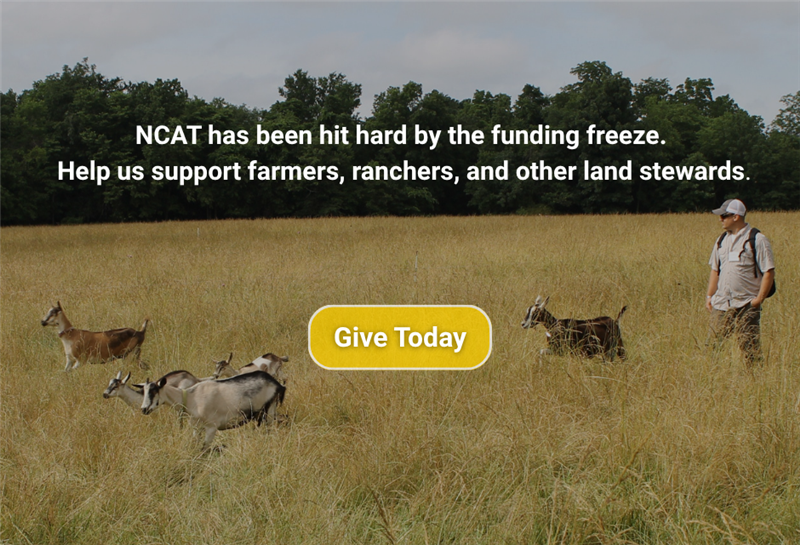Maple Sugaring: An Introduction to Small-Scale Commercial Production
By Andy Pressman and Sharon Burke, NCAT Agriculture Specialists
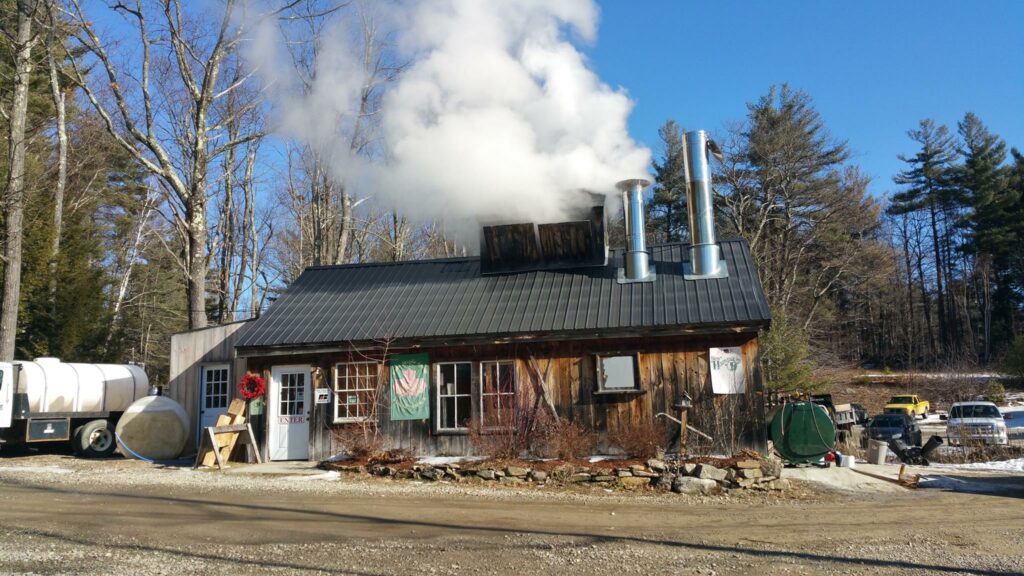
Ben’s Sugar Shack, Temple, New Hampshire. Photo: Ben’s Sugar Shack
Abstract
Producing maple syrup and value-added maple products offers an opportunity to diversify farm operations and income. This publication provides an overview of maple sugaring, including business planning, financial considerations, marketing, equipment and supplies, value-added products, organic certification, regulations, and quality control. It also includes resources for acquiring more knowledge on maple syrup production and determining if maple sugaring is a viable addition to a farming operation.
Contents
Introduction
Business Plan, Economics, and Marketing
Maple Syrup Production
Value-Added Products
Food Safety Regulations and Requirements
Potential Impact of Climate Change
Conclusion
References
Further Resources
Introduction
Maple syrup is a forest food product that is distinct to the upper North American woodlands, where maple trees grow naturally. It is made from the xylem sap of maple trees. Sap from the sugar maple (Acer saccharum) is most commonly used for maple syrup production. Syrup can also be made from sap from other native maple species, including red maple (A. rubrum), black maple (A. nigrum), and silver maple (A. saccharinum). Diversification into making syrup from other tree species, such as black walnuts, birch, and box elders, is also growing amongst producers. Sugarmakers are finding a niche market for these unique syrups. All of these trees store starch in their trunks and roots before the winter. As the temperature warms in late winter and early spring, this starch is converted to sugar that rises in the sap.
Sugarmakers have been creating maple syrup and maple products for centuries. While the history of maple syrup is rich in lore, it is most commonly believed that Native Americans were the first to discover its value as both a food and a medicine. Early American settlers used it as an alternative to cane sugar. Maple products were also valuable commodities for trading in the 1800s, making maple sugar one of the first truly American agricultural products.
The increasing demand for maple products offers an important income opportunity for those with maple stands. According to USDA National Agricultural Statistics Service, the United States produced more than 4.2 million gallons of maple syrup in 2016, valued at more than $147 million (USDA, 2017). The majority of this is grown in the Northeast, with Vermont consistently producing the most. Other states producing notable amounts of maple syrup include New York, Maine, Pennsylvania, Wisconsin, Michigan, New Hampshire, Massachusetts, Ohio, and Connecticut.
Although technology has created significant efficiencies in maple sugaring, the basic production process has not changed significantly. It remains a fairly labor-intensive operation, requiring investment in equipment that increases as the scope of operation expands. This publication is designed to provide an introduction to maple syrup production. It also includes resources that potential producers can explore to acquire more knowledge and to determine if maple sugaring is a viable option for diversifying their income streams.
Sugaring Considerations
Maple syrup is a late-winter and early-spring crop, offering an opportunity to bring in off-season income at a time when most farms are idle and farm labor is available. Even if maple syrup sales do not necessarily bring in high profits through direct sales alone, they can add overall value and visibility to farm operations by drawing new customers who are attracted by health values or by the traditional “old-fashioned” farm experience associated with maple syrup production. Andrew Fast and Steve Roberge, in an article entitled “To Tap or Not to Tap,” note that few people can make a living on maple sugaring alone (2010). As a general rule, smaller producers, defined as operations with fewer than 1,000 taps, have a difficult time being profitable if labor costs are taken into account. In fact, a highly efficient commercial setup can gross three times more per tap than a hobby operation.
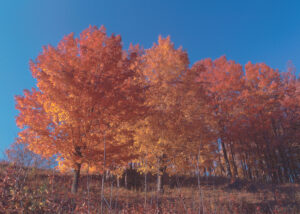
Sugar Maple Trees with fall foliage. Photo: USDA NRCS
While the potential for attractive profit exists, there are challenges inherent to maple sugaring. Most notably, sap yield is largely predicated on weather, which fluctuates year to year and makes profits unpredictable. An operation that yields 500 gallons of Grade A syrup during a year with a long sap run may yield less than half of that when the weather warms too quickly. A decline in maple syrup yield has been associated with warming spring temperatures during the critical sugaring period, as well as with increases in summer drought frequencies.
Alternative Saps
Alternative saps are becoming more popular for making syrups and other value-added products. Collecting and boiling sap from trees such as black walnuts, birches, and box elders offers a niche product that can have a higher price point than maple syrup. In addition, these maple alternatives can extend the sugaring season, as the sap run from these trees tends to occur later than maples, often hitting its peak when the volume and quality of maple sap starts to diminish. However, the sap yield and sugar content of these trees is typically lower than sugar maples, often making it challenging to have enough sap to support the enterprise economically. For example, a 60:1 sap-to-syrup ratio would not be uncommon for trees like black walnuts and box elders, and a 100:1 ratio for birch trees. The Wildfoodism website contains a list of 22 species of trees that can be tapped for making syrup.
Business Plan, Economics, and Marketing
Developing a Business Plan
As with any new business venture, the first step in establishing a maple sugar operation is to develop a comprehensive business plan. This documents your vision and goals, specific production plans and timelines, descriptions of the products you intend to sell, marketing plans, and a financial plan that includes all projected income and expenses and details how you intend to make money. Writing down your plan allows you to see how the addition of maple sugar production fits with other commitments and farm enterprises and alerts you to gaps and opportunities. It also allows you to see progress toward goals. For more information on developing a farm business plan, see ATTRA’s Business and Marketing section.
Financial Considerations
A financial plan is an integral component of the business plan and should identify all expenses, equipment and supply needs, capital investments, labor costs and availability, expected sap yields, and sales income and profit projections by product. Some of the costs to consider include sugar bush purchase, lease, and/or maintenance, building a sugar house, tapping and sap-collection equipment, gathering tanks, evaporation equipment, filtering systems, measuring instruments, bottling, labels, sanitizers, marketing/advertising, bookkeeping, utilities, fuel, insurance, and labor.
How much and how efficiently you can collect sap and evaporate water to create syrup will significantly impact the overall cost of production. Larger operations can achieve economies of scale, investing in efficient technology such as reverse osmosis units, preheating systems, larger evaporators, vacuum systems, and oil burners. Additionally, tubing collection systems with vacuum systems allow sap to be collected much more quickly, with much less labor, than do traditional collection systems that use buckets or bags.
The choice of equipment comes down to where you want to place your investment: labor (your own or others) or infrastructure. If you have more time than money, you can make your operation work with less technology. You should project the costs for equipment several years into the future and make selections that support any planned growth.
Maples are a valuable timber species, and you may also want to assess whether your stand is more profitable for maple sugar production or for timber. There are some financial implications to tapping trees that impact their value as a timber product. Tapping leaves residual scars above and below the taphole that reduce the potential saw-timber value of the first sawlog (lower 16 feet) of trees (Fast and Roberge, 2010).
Many worksheets that help determine full expenses can be found online. Penn State Cooperative Extension offers one such interactive worksheet that calculates maple syrup production costs. The resource section of this publication includes additional guides that can assist in developing business plans and determining what it really costs to produce that gallon of maple syrup. ATTRA’s publication Basic Accounting: Guidance for Beginning Farmers provides helpful information on developing a basic accounting system.
Income
On average, it takes about 40 gallons of sap to produce a gallon of syrup, and each taphole produces just over a quart of syrup.
Revenue projections should be based on a well-thought-out marketing plan that identifies viable markets and market prices before any syrup is produced. Revenues will be dictated by price points and sales. Once producing, it is essential to use a good record-keeping system to track expenses and revenue and to document sap and syrup yields and each tree’s sugar content.
Sap yield can vary greatly based on weather, collection methods, tree size, soil, genetics, and seasonal differences. Sap yield is usually expressed in terms of the number of tapholes, rather than the number of trees. Yield for a single tap can range widely. In favorable conditions, the average sap yield per taphole is around 10 to 12 gallons. Syrup yields, which also vary based on sap sugar content, should also be recorded. On average it takes about 40 gallons of sap to produce a gallon of syrup, and each taphole produces just over a quart of syrup. Accurate recording of sap yield and sugar content allows you to better manage your sugarbush, invest your time and efforts in tapping the trees that are most profitable, and make accurate projections and informed decisions based on real-time and long-term data analysis.
Market Options
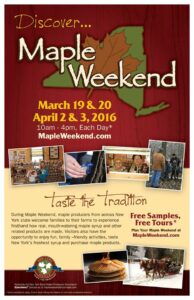 Maple sugar producers should identify markets for their sap, syrup, and value-added products and develop a cohesive marketing plan even before they tap their first maple tree.
Maple sugar producers should identify markets for their sap, syrup, and value-added products and develop a cohesive marketing plan even before they tap their first maple tree.
Maple weekend is a great way to bring folks to the sugar house. Photo: Cedarvale Maple Syrup Co (NY)
Marketing options available to producers include selling the raw sap to another producer, making the sap into syrup for wholesale or retail sales, using the syrup to create value-added products to sell, or bottling the raw sap to sell as a tonic. Each option has specific considerations:
- Selling the sap raw to another sugarmaker reduced the initial investment of production equipment, but will yield significantly lower revenue, since most of the profit is in the finished syrup. It does provide a new producer with some revenue during the process of establishing a sugarbush, offering the opportunity for learning proper tapping techniques, setting up collection lines (which can be somewhat complex to design properly), and assessing yield potential so the producer can more accurately develop data-informed business and financial plans.
- Wholesale sales of syrup and value-added maple products often reduce risks associated with retail sales by offering assured sales through established customers. Wholesale sales can help ensure that producers do not carry excess inventory. However, wholesale will yield lower revenues than retail sales, which offer more favorable margins.
- Retail markets that sell direct to consumers carry a higher return on investment through higher per-unit revenues. Selling retail requires additional time, effort, and added costs for items such as bottling equipment, bottles, labels, advertising, and promotion. Retail channels to explore include sugarhouse storefronts, direct-to-consumer Internet sales, farm stands, farmers markets, fairs, restaurants, health food stores, and others. Think outside the box to identify untapped markets, such as selling syrup to a business that sells specialty gift baskets, or maple treats as wedding favors. Open houses provide an excellent opportunity to introduce new customers to your maple sugar operation, entice people to try value-added confections, and increase sales of both syrup and other maple products.
- Pure, unprocessed maple sap is also gaining in popularity as a tonic that cleanses the body, and it offers another viable market option.
Organic Certification
USDA rules require that all producers and handlers that make a certified organic claim for their product be certified by a USDA-accredited certifying agent. A list of these can be found here. There are no federal standards for organic maple sugar production or organic sugarbush management; therefore producers must work with their certifying agent to develop an Organic System Plan that is tailored to the specific operation. Potential certifier requirements might include use of organically approved de-foamers and equipment cleaners, water testing, and confirming that the sugarbush is free of unapproved pesticides for three years prior to certification. For more information on organic certification, consult the ATTRA topic area Organic Certification.
Maple Syrup Production
Although technological advances differentiate modern-day commercial operations from those of our ancestors, the basic elements of producing maple syrup and maple products have not changed dramatically over time. There are five main production steps:
- Establishing a sugarbush, which is the industry term for a stand of maple trees for tapping
- Tapping maple trees and collecting the flowing sap in containers or through tubing
- Evaporating the excess water to concentrate the sap into syrup
- Filtering the syrup to remove impurities
- Bottling syrup and making value-added maple products.
Evaporating, bottling, and making value-added products require working with sap at very high temperatures, which presents safety hazards. These hazards can, however, be mitigated through proper safety precautions.
Maple sap does not store well and should be processed within 48 hours of collection. Anything that sap comes in contact with is concentrated during boiling, and can cause syrup to be off-flavor or off-color. This necessitates careful sanitation practices during collecting, production, packing, and storing.
Establishing the Sugar Bush
Maple-tree stands offer commercial opportunities for both sugaring and timber. Sugarbush is the term used for a stand of sap trees. Unless you have significant knowledge of forestry, it is highly recommended that you contact your district or county forester for assistance in assessing your trees for commercial maple-sugar production. Unlike managing a forest for timber, in which the tallest and straightest trees are prized, the objective of sugarbush management is to produce the highest possible yield of sugar-rich sap per acre. Sugar maples, also referred to as rock or hard maples, have the highest sugar content and longest sap runs. Black, red, and silver maples are also suitable for tapping and should not be overlooked when establishing the sugarbush, nor should other alternative tree species that are in abundance.
Sugar maple sap has an average sugar content of 2% to 3%. Because other maple species are usually lower in sugar content, approximately twice as much sap is needed to yield the same amount of finished syrup. Ornamental maples, such as the Norway and Schwedler maple, are typically not used for commercial syrup production.
There has been much research indicating that trees with large crowns, regardless of maple variety, will generally produce the most and sweetest sap. Sugar is produced in the leaves during photosynthesis, and heavy leaf cover is also thought to be an important determinate of higher sap yields. The general rule of thumb for the best spacing of trees for a commercial operation is about 50 to 60 trees per acre, with each tree in an area about 30 feet by 30 feet. Trees that are thinned can also bring value to producers: they can be used as fuel in wood-fired evaporators or sold as firewood for an added income source.
The amount of sap that can be collected and the sugar content of sap is of critical importance, because this directly impacts profit. Sugar content determines how long sap must be boiled to produce syrup. Saps with lower sugar content must be boiled longer to concentrate to syrup, which increases labor, fuel costs, and time spent in the sugar house. Other considerations in siting the sugarbush include terrain and accessibility. These impact the amount of sap that flows and how it is to be collected. The ideal location is a south-facing slope, which encourages longer, more productive sap yields, and a site that is easily accessible by foot, tractor, and vehicle, as this reduces labor in collecting and transporting sap and wood used as fuel (Hansen et al., 2010).
Sugar Content and the Rule of 86
Sugar content directly determines how much sap will be needed to produce a gallon of syrup. Sugar content varies based on a number of factors and is determined using a refractometer. The higher the sugar content, the less time it takes to boil water from sap and turn it into syrup. An increase of just 1% of sap sugar reduces processing costs significantly.
The Rule of 86 is a simple calculation in which 86 is divided by the sugar content to determine how much sap is needed to produce a gallon of syrup. For example, for sap with a sugar content of 2%, divide 86 by 2, which equals 43. In this case, 43 gallons of sap are needed to produce 1 gallon of syrup. By contrast, sap with a sugar content of 3% would require only 28.6 gallons of sap for one gallon of syrup (86/3 = 28.6).
The Rule of 86, coupled with other information, can be used as basis for estimating how much syrup a sugarbush will produce, how many trees or taps are needed to produce a specific target, and other useful information. For example, to calculate how many taps will be needed to produce 50 gallons of syrup, based on a sugar content of 2% and a per-tap sap production of 10 gallons, you would divide 86 by 2, which equals 43 gallons of sap needed per gallon of syrup. Then, you would multiply 43 by number of target gallons of syrup you want to produce (50), which equals 2,150 gallons of sap. You would then divide 2,150 by the number of gallons of sap produced per tap, which in this case is 10, to determined that you need an estimated 215 taps to produce 50 gallons of syrup (86/2=43; 43 x 50 = 2,150; 2,150/10 = 215).
Sugar House
The sugarbush is the foundation of a maple enterprise, but the sugar house is the heart and hub of operations. Also known as a sap house, sugar shack, or sugar cabin, this is the building in which the sap is collected and boiled into maple syrup. Also known as a sap house, sugar shack, or sugar cabin, [the sugar house] is the building in which the sap is collected and boiled into maple syrup. Traditionally, these buildings were rudimentary one-room, cabin-like structures. Today, many commercial sugar houses also offer storefronts and outdoor gathering spaces that are used for agritourism events such as sleigh rides, educational activities, and maple festivities. The University of Vermont Extension Service offers an excellent guide on sugar house design [PDF]. Many good design plans can also be found through an Internet search.
Tapping Trees
Once trees have been identified for tapping, based on a careful analysis of the sugarbush, the next step is to determine what type of collection systems and taps you wish to use. A tap, also referred to as spile or spout, is a metal or plastic tip that is inserted into the hole drilled into a maple tree in order to collect the sap. Taps vary in size and shape, depending on whether a traditional or tubing collection system is used.
Determining Number of Taps per Tree
Trees may be tapped when they reach 10 to 12 inches in diameter, as measured four and a half feet from the ground, also known as breast-height diameter or DBH. To measure this diameter, measure circumference by wrapping a measuring tape around the tree four and a half feet from the ground, and then divide this number by pi, which can be rounded to approximately 3.14 (diameter = circumference/3.14). Trees with a DBH of 18 to 20 inches can have two taps. Although more than two taps per tree is discouraged, very healthy trees with DBH of greater than 25 inches can sustain three taps. Unhealthy trees should not be tapped, as they will not produce sufficient or quality sap. Trees with sufficient space to develop large crowns typically are the best sap producers, although some research is indicating that this is less important than had historically been thought (Blumenstok and Hopkins, no date).
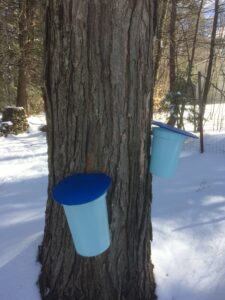
Tapped maple trees using plastic buckets. Photo: Andy Pressman, NCAT
When to Tap
Trees should be tapped just before the sap starts to flow, which occurs when daytime temperatures go above freezing and nighttime temperatures fall below freezing. This period fluctuates from year to year and with location. In the northeastern United States, this generally occurs early February to early March. The rising temperature creates pressure in the tree, generating the sap flow. Starch that was stored in the trunks and roots before the winter is converted to sugar that rises in the sap. The sap quits flowing when nighttime temperatures go above freezing and starts again when temperatures fall below freezing. Sap generally flows more quickly in the morning.
Useable sap generally flows for four to six weeks, with the best, lightest-colored sap produced early on. Light-colored sap generally is most valuable, as it produces the sweetest maple syrup and is highly sought for value-added products such as maple cream. The syrup becomes darker as the days warm and the season progresses. Darker syrup is flavorful but draws a lower price. Once a tree breaks bud, the sap becomes off-flavored and should no longer be collected.
Location of Taps
Trees are generally tapped on the south side to take advantage of the warming sun. Taps can be placed at a convenient height between two and four feet from the ground. Choose a tap site where wood is free of scars, wounds, or old tap holes. If the tree has been tapped in previous years, place the new taphole at least 12 inches above or below and two inches to the right or left of the old tap hole. In trees with more than one tap, taps should be spaced evenly around the circumference of the tree.
Installing the Taps
Tapping requires only a few tools:
- Drill
- Drill bit based on tap size: 7/16-inch drill bits are used most commonly for traditional taps and 5/16-inch drill bits are used most commonly for taps that are to be connected to tubing systems
- Hammer
- Taps
There are three main steps to installing a tap:
- Prior to tapping, sanitize the taps by dipping them in a solution of one part household chlorine bleach to 20 parts water. Remove from solution and rinse thoroughly with clean water. Do not let the taps sit in the solution for longer periods of time or use a stronger solution, because this may cause off flavors in the sap that will make the syrup unsaleable.
- Drill a hole into healthy wood using a drill-bit size that corresponds with tap size. The hole should not be deeper than two inches for larger taps and one and a half inches for smaller taps. Drill at a slightly upward angle to help sap flow from the tree. Use a sharp drill bit and slow drill speed to assure you do not cauterize the hole, which will reduce tap flow. Examine the color of the shavings from the drill. Light-colored shavings indicate healthy sapwood. Dark-colored shavings indicate rotting or unhealthy wood. If you hit bad wood, move the tap hole to a different location. Do not attempt to fill in the abandoned hole or treat with any disinfectant or other substance. It will close naturally on its own over time. Gently clean shavings from the hole (Blumenstok and Hopkins, no date). Note: Do not blow into the hole to remove shavings, because this contaminates the hole.
- Insert the spile into the hole. Use a hammer to tap it lightly until it fits snugly and cannot be pulled out by hand; this only takes a few gentle taps. Be careful not to hammer so hard that it causes the bark around the tap to split. This can lead to vacuum leaks, lost sap, and increased wounding at the taphole. Tapping on warm days minimizes risk of wood splits (Hansen et al., 2010).
The tap is then ready for use, either by hanging a bucket for traditional collecting or connecting to rubber tubing. A special tubing tool can be used to attach tubing to a tap.
Tap Removal
All spiles should be removed at the end of the season, and the holes should be left unplugged and untreated. Tapholes will close and heal naturally within a couple years, and the tree will remain productive for the rest of its life. Trees can produce sap for many decades, as long as they stay healthy. Note: It is no longer recommended to use paraformaldehyde pellets in tap holes: these pellets can damage trees and are now illegal. Do not use denatured alcohol; this too is illegal in some states, including Maine.
Collection Systems
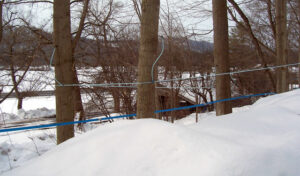
Tapped maple trees with a tube collection system. Photo: Cedarvale Maple (NY)
The two types of collection systems used by maple producers are traditional and tubing. In traditional systems, a tap is inserted into a tree, and sap is collected in a bucket or a bag. These vessels must be collected daily and emptied individually into a storage tank or facility, making this a time-intensive method suitable only for small-scale producers or hobbyists. Traditional collection systems may also be the preferred method when the site does not have ample slope to support a tubing collection system, or when the trees are widely dispersed, making a tubing system impractical.
Larger producers most often use a tubing system in which taps are attached to plastic tubes that are connected to a main line running through the sugarbush. Tubing systems can be vented or closed, and run in the air or along the ground. They can operate through gravity on a sloped site, through mechanical means using a vacuum system, or a combination of both.
Vacuum systems require a larger initial investment but can significantly increase sap yield per taphole. A mechanical vacuum pump literally pulls more sap from the tree than gravity alone would, and faster, which helps keep the sap from becoming contaminated. These systems also allow for a much smaller tap to be inserted into the trees.
Tubing systems take a bit of upfront design time to assure the greatest functionality and cost effectiveness. They can, however, save significant time and labor over the long run and are frequently less expensive to install than traditional systems that require multiple buckets or collection vessels. Tubing layout will need to take many factors into consideration, including density of maple trees, slope, terrain, obstacles, and collection points. Unless all trees are brought online at once, tubing systems should be laid out to allow future modification.
Tubing may also include the use of vertical drop lines that allow the spiles to be moved to new holes each spring without re-plumbing the line and allow separation of carbon dioxide that can contribute to vapor locks that inhibit sap flow. All tubing should be straight and tight to prevent sap from pooling in dropping lines, because this can cause bacteria to grow in the sap. The largest problems with maintaining tubing systems come from animals chewing holes in the tubing in search of food, and from the need to sanitize the lines after the season is over.
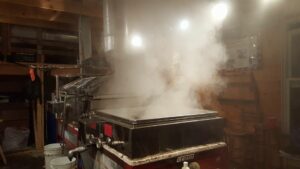
Boiling sap in an evaporator. Photo: Josh Penick, Hijinks Farm (NH)
Sap Storage
Sap is emptied, collected, or pumped into a storage tank before the evaporation process begins. Sap does not store well and should be used within two days to avoid bacterial growth. Bacterial growth begins when sap is above freezing. The warmer the air temperature is, the faster sap will spoil. When this occurs, the sap is no longer useful and should be discarded. The longer sap sits, the darker it becomes. This impacts grading, which impacts pricing. It is critical to your bottom-line profit that sap is boiled as soon as possible to maintain quality.
Evaporation and Boiling
Once sap is collected and transported to a storage tank at the sugar house, the process of evaporation can begin. The sap should be filtered to remove debris prior to evaporating. In its natural state, sap contains about 98% water and 2% sugar. Converting maple sap into syrup requires removing water from the sap, which concentrates the sugar into a syrup. In hobby operations, the sap is boiled over flames or on stoves. Commercial operations, even those on a modest scale, use some type of continuous-feed evaporator to reduce the sap to a finished syrup of 66 to 67% sugar. Some states dictate the exact minimum sugar content. For example, in Vermont and New Hampshire, the minimum sugar content is 66.9%.
Sizing the Evaporator
The size of the evaporator correlates to its capacity: the amount of sap it can process in an hour. Larger evaporators take less time to boil off the water; this impacts labor and fuel costs. Faster boiling may also yield higher quality syrup. The longer it takes to process sap, the darker the syrup becomes. Lighter sap is considered by most to be of the higher quality, and therefore people are willing to pay a higher price for it.
Sizing an evaporator can be guided in part by the number of taps and the amount of time available in a day for boiling. This is based on the idea that one tap will produce an average of one gallon of sap a day when it is running. To determine the evaporating capacity, divide the number of taps you have by the number of hours available for processing. This determines the capacity of evaporator needed. For example, if you have 100 taps and want to limit processing time to eight hours per day, you divide 100 by eight to determine that your evaporator can process 12.5 gallons of sap in an hour (100 gallons/8 hours = 12.5 gallons/hour). Remember, though, that when the sap is really running fast, you may get runs of up to four or five gallons per tap. While this may only occur a few days each season, a plan should be in place to manage this so the sap does not spoil. An evaporator is a long-term investment and should last for decades if properly maintained.
| Table 1: Estimated Sizing of the Evaporator | ||||||||
| Evaporator Size | 2’x 4′ | 2′ x 6′ | 2′ x 8′ | 2′ x 10′ | 2.5′ x 10′ | 2.5′ x 12′ | 3′ x 8′ | 3′ x 12′ |
| Capacity (Gallons per hour) |
15-20 | 25-30 | 35-40 | 45-50 | 55-60 | 70-75 | 70-75 | 90-95 |
| Source: Based on a compilation of average-capacity data from several manufacturers, 2016 | ||||||||
Table 1 offers a rough guide of evaporator capacity range. It is important to check specifications carefully before purchasing an evaporator because the capacity varies by model and add-on features.
Increasing Energy Efficiency
Beyond the size of the evaporator, there are other factors that can influence the amount of time it takes to reduce the sap to syrup: types of pans, types of flues, fuel source, and the intensity/quality of fire if using wood. Additionally, maple producers have access to a variety of pre-processing technologies that can increase efficiency of processing. For example, a sap preheater recycles steam from the evaporator to pre-heat sap, thereby reducing cook time. A steam-enhanced “piggyback” unit uses both recycled steam and forced hot air to concentrate sugar content. A freeze-concentration unit, still somewhat experimental, uses refrigerated pipes to crystalize and remove water and increase sugar content prior to processing. Vapor compression removes captured steam and compresses it to raise the temperature of incoming sap.
Although all of these technologies reduce the water-to-sugar content incrementally, a reverse-osmosis system is the pre-processing method that most dramatically increases sugar content. In this system, the feeder tank is connected to a reverse-osmosis unit. The sap is forced under very high pressure through a semi-permeable membrane through which water can pass, but sap cannot. This results in removing as much as half the water before the sap enters the evaporator, and raising sugar content from 1 to 3% to as high as 10%.
Reverse osmosis requires a fairly substantial investment, but can quickly pay off for commercial producers by reducing evaporator fuel costs and boiling time. The USDA often offers agricultural producers grants and loans for energy improvements, including installation of reverse-osmosis equipment. One such opportunity is the Environmental Quality Incentives Program (EQIP) offered through USDA’s Natural Resources Conservation Service.
Finishing
By U.S. federal statute, syrup must test at minimum 66% sugar or 11 pounds to the gallon. Some states require slightly higher sugar content. Finishing sap at the proper concentration or density is critical: the syrup will crystallize when finished at too high a density and will spoil when finished at a density that is too low.
| Table 2: Syrup Hydrometer Correction Chart | ||
| Syrup Temperature | Baume Reading | Brix Reading |
| 209 | 32.0 | 59.0 |
| 202 | 32.25 | 59.6 |
| 193 | 32.5 | 60.0 |
| 185 | 32.7 | 60.4 |
| 176 | 33.0 | 60.9 |
| 167 | 33.25 | 61.4 |
| 158 | 33.5 | 61.8 |
| Source: USDA United States Standards for Grades of Maple Syrup, 3/2/2015. | ||
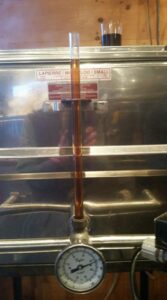
Finished syrup being warmed and ready for bottling. Photo: Josh Penick, Hijinks Farm (NH)
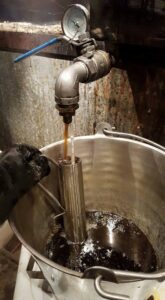
Syrup hydrometers, like the one shown here, are what is required for measuring the higher percentage of sugar found in maple syrup. Sap hydrometers are useful in determining which trees have sweeter sap and for calculating how many gallons of sap it will take to make one gallon of syrup according to Jones Rule of 86. Photo: Josh Penick, Hijinks Farm (NH)
Syrup is denser than water and boils at 7.5 °F above the boiling point of water. Density is measured with a syrup hydrometer, which floats at different heights in a sample of syrup depending on the liquid’s density. The boiling point of water changes with barometric pressure, so adjustments may need to be made throughout the day to assure the sugar-to-water density. In the absence of a hydrometer (the recommended method), density can be measured using a quality candy thermometer to measure boiling temperature, which is a function of density. The more dense the liquid, the higher the boiling temperature. When finishing syrup, check the boiling point of water and add 7.5 °F to arrive at the correct temperature to produce syrup of the proper density.
Maple syrup hydrometers are generally calibrated for 211° F. If you are testing maple syrup that is colder than 211° F, a temperature-correction chart should be used to determine if the syrup is “light” or “heavy.” Heavy syrup is represented by a reading on the hydrometer that is higher than the number on the chart, and it will need to be diluted. A light syrup refers to a hydrometer reading that is lower than the number in the chart, and requires that the syrup be boiled more. For example, if the syrup being tested is at 202° F and the hydrometer floats at 32.25 Baume or 59.6 Brix, the syrup is finished.
Defoaming
While sap is boiling, a foam may develop. Left unchecked, this could potentially cause the evaporator to overflow. A couple drops of a commercial defoaming agent or vegetable/canola oil can be used to reduce the foam. Organic producers should take care that their defoaming agent meets organic standards.
Filtering, Bottling, Grading, and Labeling
Once the sap has turned to syrup, it is drawn off the evaporator into a holding tank, where it is stored until it is ready to be bottled. When the syrup is removed from the evaporator, it contains niter, which are solidified minerals found naturally in maple syrup, known as “sugar sand.” These are removed by filtering the syrup through a series of filters made of various materials or through a filter press. This removes impurities and will leave the syrup clearer.
The type of filtering system and the materials of which it is made are based on size of operation and personal preference. Some of the many filter options are paper, cheesecloth, Orlon, and wool. Diatomaceous earth, sometimes referred to by its brand name Celite, can be used as a filtration aid to filter very fine particles that would otherwise pass through or clog filter paper. Using a paper-type pre-filter inside an Orlon or wool filter will increase the capacity of the main filter. Sediment will clog filters, so they must be thoroughly cleaned and rinsed to prevent any off-flavoring caused by the use of cleaning agents and then dried to avoid being contaminated with mildew or bacteria.
After filtering, the syrup is stored or prepared for bottling. Syrup must be packed hot. Prior to bottling, it is heated to 190°F or higher to kill any bacteria, and packed hot into sterile, airtight containers for sale. Containers should be at room temperature prior to filling, to avoid breakage when the hot syrup hits the container. Containers should be capped immediately, placed upside down to seal them, and then placed on their sides to cool. This assures a long shelf life when left unopened.
| Table 3: United States Standards for Grades of Maple Syrup, effective 3/2/2015 | ||
| Grade A Color Classes | Taste | Light Transmittance (% Tc) |
| U.S. Grade A Golden | Delicate | Greater than or equal to 77.5 |
| U.S. Grade A Amber | Rich | 50.0 – 74.9 |
| U.S. Grade A Dark | Robust | 25.0 – 49.9 |
| U.S. Grade A Very Dark | Strong | Less than 25 |
| Processing Grade is syrup that does not meet Grade A requirements, but meets requirements for use in the manufacturing of other products. Maple syrup for processing must be packed in containers of five gallons or 20 liters or larger and cannot be packaged in consumer-size containers for retail sales. | ||
| Substandard is the quality of maple syrup that fails to meet the requirements for U.S. Grade B for Reprocessing. It is not intended to be sold in retail markets and may be used to make other products. | ||
Maple syrup containers are made of tin, plastic, or glass and come in many sizes and decorative shapes. Producers have a large selection of maple containers to choose from and should select these based on budget, brand, and marketing plan.
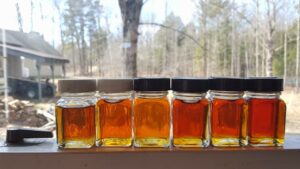
Photo: Josh Penick, Hijinks Farm (NH)
Maple syrup is graded based on its translucency and flavor. Some states maintain their own standards. States without regulations use the United States Department of Agriculture (USDA) voluntary standards, which were revised in February 2015 to match international standards. The USDA standards are indicated in Table 3.
In addition to distinctive containers, labeling offers another opportunity to further customize and market your product. Many maple suppliers offer private labeling and/or custom packaging. An eye-catching label can help your product stand out and can reinforce your brand. The U.S. Food and Drug Administration (FDA) requires all maple sugar labels to contain grading, ingredients, name and address of farm, and net contents volume. Many of the commercially available containers feature grade, ingredients, and volume preprinted on the container.
Value-Added Products
Offering value-added maple products provides an additional opportunity to generate revenues. Some widely marketed examples of value-added products are maple cream, maple candy, and maple sugar. All are made by reheating and cooling the syrup, using various methods to create the desired confectionary.
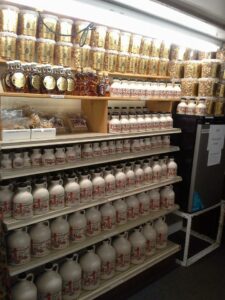
Pure maple syrup and maple products. Photo: Loch’s Maple (PA)
Maple cream is created by boiling maple syrup to 234°F and then rapidly cooling and continuously stirring until it reaches a consistency like peanut butter. It is often used as a spread for breads and crackers, or a dip for fruits and pretzels. One gallon of maple syrup will produce around eight pounds of maple cream, which illustrates the potential for profitability of value-added maple products.
Maple candy is made by boiling syrup until it reaches 235°F, then removing it from the heat until it cools to about 175°F. At this point, it can be poured directly in a mold to make a clear hard candy or stirred until it becomes thick and creamy to make soft candy.
Maple sugar is produced by heating maple syrup until the temperature is 258°F to 262°F. It is then allowed to cool to about 200°F, and stirred by hand and mechanical means until granulation has occurred.
Other value-added products include maple jelly, maple candy-coated nuts, maple cotton candy, maple nut popcorn, maple rock candy, maple toffee, and maple taffy. Additional product ideas and recipes can be found in the North American Maple Producers Guide listed in the Further Resource section.
Food Safety Regulations and Requirements
Maple sugar producers should check with their state departments of agriculture to assure they are following all applicable licensing, registration, and food-safety regulations, as these vary from state to state. Maple producers may require multiple licenses depending on their specific operation and location, such as maple syrup processing licenses, a mobile food vendor license, a home processor license, or commercial processor license.
Producers may also be held to safety standards relative to physical structure and facility, equipment and utensils, sanitation, water supply, rodent control, hygiene practices, ventilation, lighting, additives, byproducts, retail containers, storage facilities, and labeling. With regard to the federal regulations, all sugarmakers must register with the FDA and follow the standards spelled out in the federal Good Food Manufacturing Practices (GMPs).
Quality Control
Food safety and elimination of contamination are paramount in all phases of maple production. The Maple Syrup Quality Control Manual notes that the most important contributor to maple syrup quality is cleanliness (Hopkins, 2016). The guide offers valuable information on quality control during all phases of maple syrup production, including three key points:
- Microorganisms, bacteria, and yeast affect both color and flavor. Since these are often found on unclean equipment and may grow rapidly in sap and syrup, careful sanitary practices are critical during collection, processing, bottling, and storing syrup and value-added products.
- Anything added to sap, even in minute quantities, will become concentrated as the sap is boiled to syrup, causing off-flavor. Most cleaning compounds cannot be used in maple production. Household detergents, soaps that have any fragrance, and iodine-based dairy sanitizers cannot be used to sanitize syrup-production equipment because they can ruin syrup flavor, making the syrup unsaleable. One part unscented chlorine bleach to 20 parts clean water (1:20) may be used for rinsing, but equipment will need to be flushed afterwards with plenty of clean water.
- Plenty of “elbow grease” and lots of clean hot water are the best cleaning agents for maple syrup production equipment.
Appropriate Technology Considerations for Maple Syrup Production
- Vacuum Pressure Tubing Systems suck sap out of trees, which can increase sap yields.
- Reverse Osmosis Machines separate water from sugar and minerals, thus increasing the sugar content of the sap. Reverse osmosis machines often require an expensive initial investment, but they offer significant energy-cost reductions.
- Sanitation Improvements, such as reducing microbial contamination at the tap hole through spout and tube replacements, can increase yields (Jaidka, 2015).
Potential Impact of Climate Change
Like many agriculture operations, the maple sugaring industry is directly linked to the weather. The warming and fluctuating temperatures associated with climate change have the potential to impact the industry over time. When the temperature warms too soon, it shortens the sap run and reduces the capacity for production of maple syrup and value-added maple products. According to climate models studied at the Proctor Maple Research Center in Vermont, warming climate temperatures indicate a decrease in sap runs by three days, amounting to a 10% overall decrease in the average maple season (Jaidka, 2015).
Warming temperatures are also of concern along the southern fringes of the industry, such as Virginia. Future warming could potentially restrict sap flow to a degree that makes these regions unsuitable for maple syrup production (Kahn, 2016). The effect of a poor season is amplified because overall production costs do not decrease proportionately: it takes about the same amount of labor and equipment to maintain the trees and complete the processing during a fragmented sugaring season as it does through a highly productive season.
There is also some concern that warming spring temperatures during the critical sugaring period and increase in summer drought frequencies are both affecting sugar content and flavor of maple products. Other threats could potentially interact with climate changes to create more widespread challenges to the maple industry, including the arrival of invasive pest species, such as the Asian Longhorn Beetle, and risk of drought and forest fires that are influenced by warming temperatures.
Conclusion
Maple syrup production and sale of value-added maple products offer a viable income opportunity to producers, particularly those interested in diversifying farm operations. Investment in infrastructure can be substantial, and tapping, collecting, and boiling sap can be very labor intensive, although technology can lessen labor demands. Success with a maple enterprise depends upon having good sap runs, as well as having a strong business and marketing plan supported by a good record-keeping system. Adherence to food-safety regulations and maple syrup standards is required by law.
An Inside Look at a Commercial Sugar Shack
Cedarvale Maple Syrup Company, Syracuse, New York
The Cedarvale Maple Syrup Company is a certified organic maple operation located in Syracuse, New York. It is owned and has been operated by Karl and Mary Wiles since 1977. The company uses a traditional 5-foot by 12-foot wood-fired evaporator. The evaporator boils off about 250 gallons of water per hour. It takes one full cord of fully dried hardwoods to fuel the evaporator for eight hours. If the evaporator were oil fired, it would need 75 gallons of fuel oil to replace that full cord of wood. The evaporator produces approximately six to seven gallons of syrup per hour of operation. To save wood and be more energy-efficient, they also use a reverse-osmosis filtering unit that concentrates the sap before it goes to the woodfired evaporator. When they do this, their syrup production from the wood-fired evaporator jumps as high as 25 gallons per hour of operation.
The process is continual, with sap always coming in and fully cooked syrup being “drawn off” every 15 minutes or so. Although the pans usually have only about 1½ inches of liquid in them, the thickened sap tends to foam wildly as it approaches the syrup state and uses the full 10-inch height of the uncovered front pan. The covered portion of the larger, rear pan (the flue pan) is a third pan (called a “piggy back” pan) where the sap enters first. The steam from the bottom-flue pan, combined with air forced into the sap by a large fan, produces the preliminary evaporation at a temperature below the boiling point of water. The sap next enters the flue pan, which has long, narrow chambers extending below the pan into the firebox to greatly increase the surface area of the pan for greater heat exchange. The fire rushes between these long, narrow flues allowing this pan to do the majority of the evaporation.
Growing Through the Years
The Story of Loch’s Maple and Fiber, Springville, Pennsylvania
Like many other sugarmakers, Randy Loch was attracted to the maple industry due to a love of the outdoors and an enjoyment of the natural flavor of maple syrup. He began Loch’s Maple in 1981, with just 50 taps that collected sap with traditional metal buckets. He and his father boiled the sap over an open fire in a sap house made from construction scaffolding covered with a tarp. In the next few years an old grain building was skidded from 1/4 mile away and placed on the site now occupied by today’s sap house. A 3-foot by 10-foot evaporator was purchased and installed, and plastic tubing replaced the buckets.
In 1993 Randy married Jamie, and the business continued to expand. They decided it was time to put an addition on the sap house and give it a facelift. Along with the building improvements, more taps were added, leading to the need for a bigger evaporator. In 1994 a 4-foot X 12-foot evaporator was added to the sap house. In 1998 they expanded tapping and added a “piggy back” pan, which increased the evaporating capabilities to more than 300 gallons of water per hour. In 2001, they added a reverse-osmosis machine to the operation, which by now had expanded to 4,000 taps connected by some 30 miles of tubing. Through all these changes, the original structure of the 100-year-old grain building still stands, symbolizing Randy and Jamie’s love of preserving the old traditions of Pennsylvania life.
References
Blumenstok, B. and K. Hopkins. No date. How to Tap Maple Trees and Make Maple Syrup. University of Maine.
Fast, A. and G. Roberge. 2010. To tap or not to tap. Northern Woodlands. Spring.
Hansen, R., S. Childs, L. Kime, and J. Harper. 2010. Ag Alternatives: Maple Syrup Production. Pennsylvania State University Extension.
Hopkins, K. 2016. Maple Sugar Quality Control Manual. University of Maine Cooperative Extension.
Jaidka, R. 2015. Morse Farm Maple Sugarworks: Resilience through Technology. Sustainability Briefing, University of New Hampshire.
Kahn, B. 2016. Climate Change Is Coming For Your Maple Syrup. Climate Central.
Pitcoff, W. 2015. Maple syrup and the new U.S. food safety rules. Maple Syrup Digest. December.
Randall, J. 2010. Maple Syrup Production. University of Iowa Forestry Extension.
Rogers, G. 2007. What Does it Really Cost to Produce That Gallon of Maple Syrup? University of Vermont Extension.
Vogt, C. No date. Minnesota Maple Series: Identifying Maple Trees for Syrup Production. University of Minnesota, Department of Forest Resources
Wells, G. 1982. Sugar House Design. University of Vermont Extension.
USDA National Agricultural Statistics Service. 2017. Crop Production. June 9. p. 9.
Further Resources
Online Course
Introduction to Maple Syrup Production. BF 152. Northeast Beginning Farmers Project.
Publications
Crop Production. 2017. By USDA National Agriculture Statistics Service. June 9. p. 9.
This annual report provides statistics by state on maple syrup production indicators including sap and syrup yields, number of taps, price and value, season open and close dates, and sales by type.
Maine Maple Syrup Production Costs. 2009. By Aaron Hoshine. University of Maine.
This one-page information sheet contains numerous graphics that provide insight into production costs.
Maple Syrup Quality Control Manual. 2016. By Kathy Hopkins. University of Maine.
This manual provides information on maintaining quality in all phases of production.
Maple Sugaring. 2013. By Stephen Roberge. University of New Hampshire.
This four-page guide provides tips for beginning maple sugar producers.
Maple Syrup Production for the Beginner. No date. By Annie L. Davenport, Pennsylvania State University, and Lewis J. Staats, Department of Natural Resources, Cornell University Cooperative Extension.
This beginner guide provides an introduction to maple syrup production.
Maple Syrup Production. 2010. By Jesse A. Randall. Iowa State University Forestry Extension.
This four-page article provides an educational overview of maple syrup.
Sugar House Design. 1982. By Grant D. Wells. University of Vermont Extension Services.
This 27-page publication provides extensive information on designing sugar houses.
Sugarbush Lease Agreement. 2003. By Larry Myott and Gregory Rainville. University of Vermont.
This is a sample of a sugarbush lease agreement.
Sugarbush Management: A Guide to Maintaining Tree Health. 1990. By David Houston, Douglas Allen, and Denis Lachance. USDA Forest Service.
This 56-page guide provides comprehensive information on maintaining a sugarbush.
Books
The Maple Sugar Book, Anniversary Edition. 2000. By Helen and Scott Nearing. Chelsea Green Publishing Company, White River Junction, VT.
This timeless book offers an account of the art and history of sugaring.
Maple Sugaring: Keeping It Real in New England. 2015. By David K. Leff. Garnett Books, South St, Reading RG1 4QS, United Kingdom.
Maple Sugaring gives readers an intimate look at the art and science of America’s favorite sweet. These stories, told by real-life sugarmakers, reveal how this ancient industry has continued into the twenty-first century.
North American Maple Syrup Producers Manual, Second Edition. 2006. Ohio State University.
This comprehensive manual on maple sugar production contains contributions from twenty educators, researchers, and maple producers from across the maple region.
Maple Sugaring Equipment and Material Suppliers
There are hundreds of maple equipment suppliers in the United States and Canada. Below are just a few:
Andersons Pure Maple Syrup
Bascom Maple Supplies, Inc.
Leader Evaporator
Lochs Maple and Fiber
Maple Source
Smoky Lake Maple Products
Sugar Bush Supply Company
Tap My Trees, LLC
The Maple Guys, LLC
Associations for U.S. Maple Producers
Indiana Maple Syrup Association
Maine Maple Producers Association
Massachusetts Maple Producers Association
Michigan Maple Syrup Association
New Hampshire Maple Producers Association
Maple Syrup Producers Association of Connecticut
North American Maple Syrup Council
New York State Maple Producers Association
Ohio Maple Producers Association
Pennsylvania Maple Syrup Producers Council
Vermont Maple Sugar Makers’ Association
Wisconsin Maple Syrup Producers Association
Cooperative Extension Websites
Cooperative Extension offices provide a wealth of educational resources related to maple syrup production and sugarbush management, which can provide valuable assistance to both the hobbyist and commercial producer. This publication was developed, in part, through information provided by the following websites.
Cornell Maple Program
Iowa State University, Forestry Extension, Maple Sugar Production
Pennsylvania State University Forest Resources, Maple Syrup Production
University of Maine Cooperative Extension, Natural Resources-Maple Syrup Production
University of New Hampshire Cooperative Extension-Maple Syrup
University of Vermont Extension Maple (includes maple sugar operation projected income worksheets)
Maple Sugaring: An Introduction to Small-Scale Commercial Production
By Andy Pressman and Sharon J. Burke, NCAT Agriculture Specialists
Published August 2017
©NCAT
IP526
This publication is produced by the National Center for Appropriate Technology through the ATTRA Sustainable Agriculture program, under a cooperative agreement with USDA Rural Development. ATTRA.NCAT.ORG.


